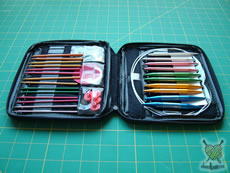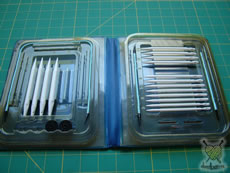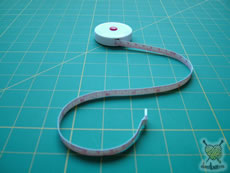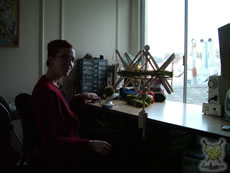Home | About Us | Contact Jennifer Stafford
how to's: knitting tools
I've been knitting since 1978. Early projects were plagued by poor quality tools and yarns. If you're serious about knitting, having fun knitting, or getting your knitting freak on, then check out the tools I've discovered that save time and frustration with common knitting activities.
Boye Needle Master
I've only had my Boye interchangeable knitting needle set for 12 years, but I still reach first for my Denise kit. The plastic cables in mom's 40 year old Boye Needle Master kit are brittle 40 years later, but their new kit is made with metal points and nylon cables in sizes 2-15 US. Replacement parts are available from Boye. Knitters I know who've used both sets seem not to prefer this one, although some do have a preference for metal. The joins are threaded like a screw and tend to come loose with fervent knitting.
Denise plastic knitting needle set
My first set of Denise interchangeable needles are still going strong 22 years later, with only a little gap at one joint. I'm sure the new set is even better, but I haven't had an opportunity to try it yet. The Denise set is widely available online and includes needle sizes 5-15 US. As you can see from this picture, a couple of pair had a project on them, so they couldn't pose for this shot. This poor little case is brittle and sun stained. But I still have all the pieces 22 years later! More than I can say for the Boye set. The Denise tips twist on with a quarter turn (rather than threads on the Boye kit) and I can't recall one of them ever coming loose. Results of a recent non-scientific poll of the knitlist showed a marked preference for the Denise kit.
full spectrum lighting
If you are selecting colors, natural daylight or full spectrum lighting is essential. It also helps to keep you in good spirits!
notched yarn cutter
This little number will snicker-snack through any yarn in a heartbeat. It's an essential for any knitter's bag that will probably even make it through airport security.
quality steam iron
I rarely block, but occasionally, a burst of steam is just what's needed to smooth out stitch inconsistencies or a seam that's just been stitched. Never press your knitting by actually placing the weight of the iron on top of the knitting, but rather, hover the iron over the piece while steaming generously. Pressing will cause the stitches to flatten and lose definition. For cable or texture patterns, steam only lightly, and define the cables and patterns with your fingers as it cools. If your knitting has any nylon fiber content at all, it should absolutely not be steamed. In some yarns, nylon may have been used as the core or binding thread, in which case your knitted piece will fall apart when the nylon melts.
retractable tape measure
This indispensable item fits neatly into any knitting bag. I actually carry one in my purse to check if clothing at the store will fit based on its measurements. Having a measuring tape instead of a flat measure means you can also use it to measure yourself or anything else that is curvy. The retractable button means it will never be tangled in your bag.
My mom taught me a nifty trick years ago: learn the specific measurement of a body part, (preferably something that you have out all the time, like your hand) since you will always have it with you. For example, my outstretched hand is exactly 8 inches long from thumb to pinkie. Conveniently, 3 of these make 2 feet.
sewing machine
As traumatic as it sounds to most knitters who don't sew (and to many who do), sometimes putting your knitting down on the sewing machine is the best thing you can do for it. This technique enables you to knit more rows in the round and then cut open the finished work (steeking) to insert a front placket, armhole or etc. Just keep in mind that cutting into the knitting fully commits you to that design, since rejoining yarns ends once a row is no fun to do with the remnants.
umbrella knitting swift and ball winder
You know you are a hard-core knitter when you own the ball winder and umbrella yarn swift and use them all the time. Using the swift sure beats asking anyone else to hold yarn, and the ball winder does a much neater job than I ever could. If you tend to wind balls too tightly by hand, this will help you tension better. I've also noticed that some yarns are available in larger hanks, or at better prices when they are not pre-wound. I asked for these items at the holidays two years ago, and the savings of time and money alone make them gifts that keep on giving.





 Get this pattern and more when you buy the book!
Get this pattern and more when you buy the book!